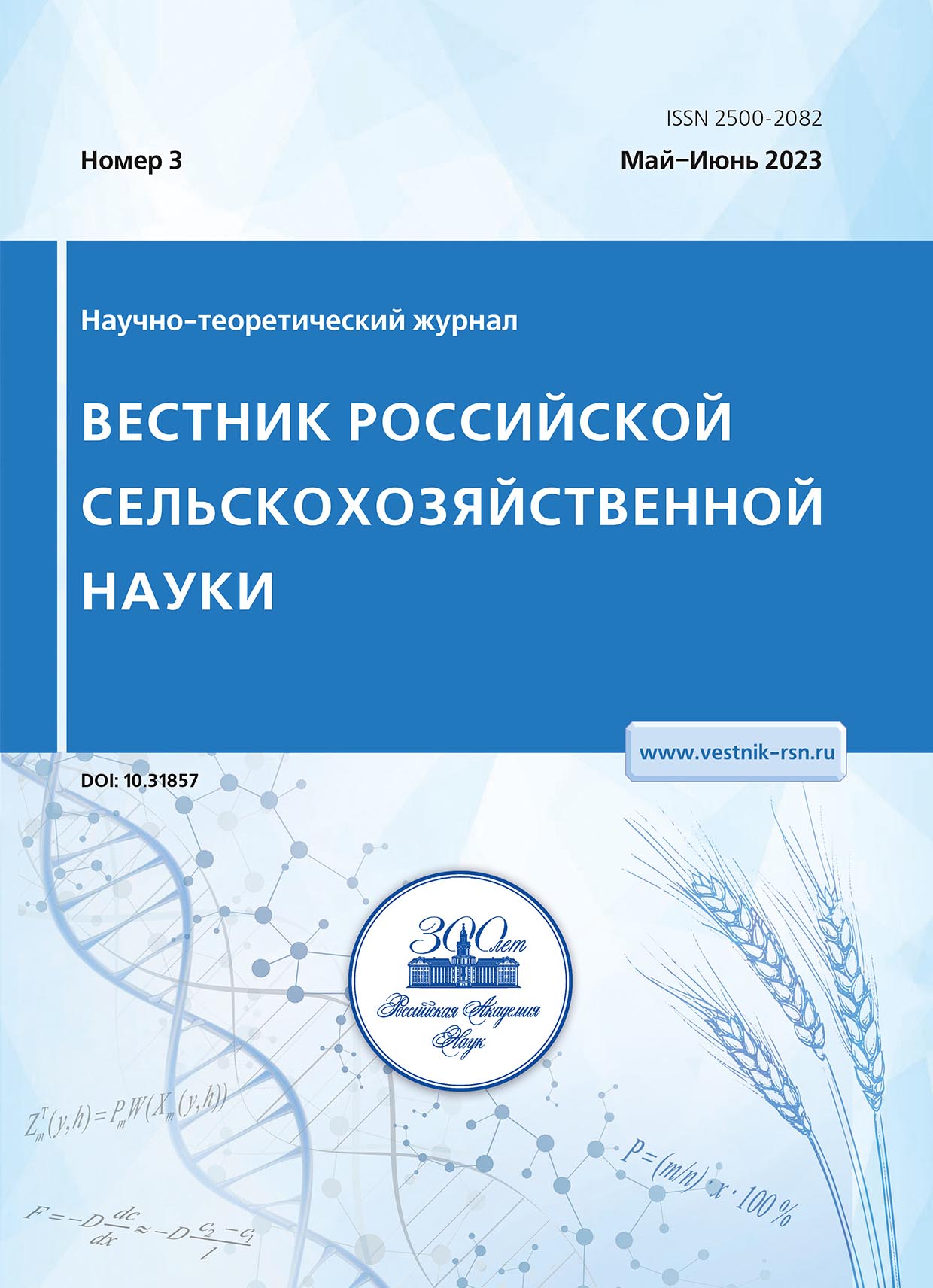EVALUATION OF THE MECHANICAL AND BIOCHEMICAL COMPOSITION OF RARE CITRUS TAXA FRUITS IN THE RUSSIA’S HUMID SUBTROPICS
Abstract
In the present study, an assessment was made of the mechanical and biochemical composition of the fruits of rare citrus taxa grown in the humid subtropics of Russia. The studies were carried out on the basis of the bioresource collection of citrus crops of the Federal Research Center "Subtropical Scientific Center of the Russian Academy of Sciences" (Sochi). The objects were 13 taxa of the genus Citrus belonging to the rare category: C. aurantiifolia Sw. (cv. ‘Tahiti’, cv. ‘Foro’), C. × aurantium var. myrtifolia Ker Gawl. cv. ‘Cinotto’, C. × bergamia Risso Poit., C. × ichangensis Sw., C. limon L. ‘Del Brasil’, C. × limonelloides Hayata, C. × limetta Risso cv. ‘Chontipico’, C. maxima Burm. Merr. cv. ‘Sambokan’, C. medica L. (var. sarcodactylus Sw.), C. × meyerii Yu. Tanaka. Measurement of the mass concentration of organic acids, sugars and vitamin C was carried out by capillary electrophoresis using the Kapel-105M system. The results showed that the studied taxa have fruits with different mechanical and biochemical composition. All studied rare taxa were divided into three groups according to fruit weight: small-fruited, medium-fruited and large-fruited. Taxa C. × meyeri, C. maxima cv. ‘Sambokan’, C. aurantifolia, C. aurantifolia had a high juice yield from 51.3 to 57.2%. The maximum levels of vitamin C were noted in C. × aurantium var. myrtifolia ‘Cinotto’, C. × limetta ‘Chontipico’ and C. medica. Among the organic acids identified, citric and malic acids were the most common, followed by tartaric and succinic acids, although other acids predominated for some taxa. Most samples have the highest amount of sucrose, followed by fructose and glucose. The least amount of sucrose was found in C. aurantifolia ‘Foro’, C. × aurantium var. myrtifolia ‘Cinotto’ and C. × limetta ‘Chontipico’ Fruits of C. × aurantium var. myrtifolia ‘Cinotto’, for C. maxima ‘Sambokan’, for C. × limetta ‘Chontipico’. For all the studied objects, a high assessment was given to the appearance of the plant, fruits, which indicates their decorative properties.
References
2. Gorshkov V.M., Abil'fazova Yu.S., Vikulova L.S. Biohimicheskie pokazateli kachestva plodov mandarina, vyrashchivaemyh v subtropikah Rossii v sravnenii s plodami importnoj produkcii //Novye tekhnologii. 2019. №.4. S. 125-135. DOI: 10.24411/2072-0920-2019-10412
3. Katalog citrusovyh kul'tur. Kollekciya GNU VNIICiSK Rossel'hozakademii / sost. V.M. Gorshkov, V.A. Fogel', R.V. Kulyan; pod red. A.V. Ryndina. Sochi: GNU VNIICiSK Rossel'hozakademii, 2013. s. 91.
4. Kulyan R.V., Samarina L.S., Rahmangulov R.S. i dr. Geneticheskie resursy citrusovyh kul'tur v Rossii, Ukraine i Belarusi: hranenie i ispol'zovanie // Vavilovskij zhurnal genetiki i selekcii. 2017. T. 21. №5. S. 506-514. DOI: 10.18699/VJ17.21-o
5. Standart EEK OON FFV-14, kasayushchijsya sbyta i kontrolya tovarnogo kachestva plodov citrusovyh, N'yu-Jork i Zheneva, 2017.
6. FAO. Faostat: Citrus fruits, oranges, lemon, total, production quantity (tons) - for all countries. 2020. [Electronic resource]. Mode access: http://faostat.fao.org. Data dostupa 08.09.2022.
7. Gorinstein S. Martı́n-Belloso O., Park Y.S. et al. Comparison of some biochemical characteristics of different citrus fruits // Food chemistry. 2001. V. 74. №. 3. P. 309-315. doi.org/10.1016/S0308-8146(01)00157-1
8. Igamberdiev A.U., Eprintsev A.T. Organic acids: the pools of fixed carbon involved in redox regulation and energy balance in higher plants // Frontiers in Plant Science. 2016. V. 7. P. 1042. doi.org/10.3389/fpls.2016.01042
9. Mditshwa A., Magwaza L.S., Tesfay S.Z. et al. Postharvest factors affecting vitamin C content of citrus fruits: A review // Scientia Horticulturae. 2017. V. 218. P. 95-104. doi.org/10.1016/j.scienta.2017.02.024
10. Kulyan R., Belous O., Konnov N. Qualitative characteristics of collectible forms Citrus reticulata Blan. var. unchiu Tan. // BIO Web of Conferences (International Scientific and Practical Conference “Innovative Technologies in Agriculture”) 2022. Vol. 47. DOI: https://doi.org/10.1051/bioconf/20224706006
11. Pan T., Ali M.M., Gong J. et al. Fruit Physiology and Sugar-Acid Profile of 24 Pomelo (Citrus grandis (L.) Osbeck) Cultivars Grown in Subtropical Region of Chin // Agronomy. 2021. V. 11. №. 12. P. 2393. doi.org/10.3390/agronomy11122393
12. Satari B, Karimi K. Citrus processing wastes: Environmental impacts, recent advances, and future perspectives in total valorization /Resources, Conservation and Recycling. 2018. V. 129. PP. 153-167. doi.org/10.1016/j.resconrec.2017.10.032
13. Singh B., Singh J.P., Kaur A., Singh N. Phenolic composition, antioxidant potential and health benefits of citrus peel // Food Research International. 2020. V. 132. P. 109-114. doi.org/10.1016/j.foodres.2020.109114
14. Tareen H., Mengal F., Masood Z. et al. Determination of Vitamin C content in Citrus Fruits and in Non-Citrus Fruits by Titrimetric method, with special reference to their nutritional importance in Human diet // Biological Forum. Research Trend. 2015. V. 7. №.2. P. 367. ISSN: 2249-3239
15. Zhang J., Ritenour M.A. Sugar composition analysis of commercial citrus juice products // Proceedings of the Florida State Horticultural Society. 2016. V. 129. P. 178-180.
16. Zhang S., Shi Q., Albrecht U. Comparative transcriptome analysis during early fruit development between three seedy citrus genotypes and their seedless mutants // Horticulture research. 2017. V. 4. doi.org/10.1038/hortres.2017.41


